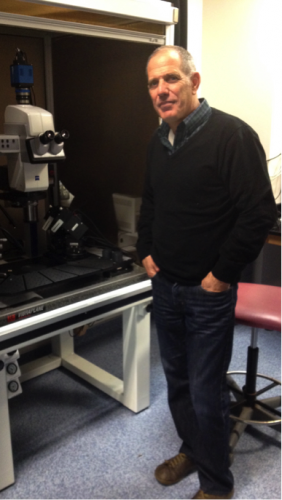Medical research
Prof working to uncover link between brain trauma and epilepsy
Research by Dal professor Alon Friedman aims to shed light on how injuries and infections lead to seizures

caption
The brain waves during an epileptic seizure.
caption
Alon Friedman in his lab at DalhousieA Dalhousie professor is gathering more information in his lab to discover what exactly causes a healthy brain to become epileptic.
“Any brain can have seizures,” said Alon Friedman.
Alon Friedman is a leading researcher for epilepsy and is the head of the Dennis Chair epilepsy research at Dalhousie University where he is a professor in the neuroscience department.
Friedman, in his research lab, is focusing on the changes that occur in the brain: “What happens in the brain from the time it was healthy, to a brain that develops epileptic seizures?” he asks.
Friedman was a professor at Ben Gurion University of the Negev in Israel where he received his PhD. In recent years, his work has been published in journals such as Nature of Neuroscience and the Journal of Neuroscience.
Friedman is conducting research to find out how the brain becomes epileptic.
“The difference between people who are epileptic and people who are not epileptic is their [seizure] threshold,” said Friedman, referring to the body’s natural resistance to seizures, which ranges among individuals.
His research involves looking at how much effort is needed “to bring the brain into an epileptic state.”

caption
The brain waves during an epileptic seizure.Friedman stated that any trauma to the brain could induce an epileptic seizure. These traumas can be anything from someone coming back from a war zone, having a car accident, experiencing emotional trauma or falling and hitting their head.
Whether the cause involves trauma, infection or inflammation, “there is some kind of process where after a brain injury… the brain can become epileptic,” he said.
According to Freidman, during an epileptic seizure, there are changes in the electrical activity in the brain. When these changes occur, the brain starts speaking differently within seconds — causing an epileptic seizure.
Since the brain is switching into different modes, the whole brain stops working together. Friedman says people often lose consciousness during an epileptic attack.
Since it would be challenging to open up a human brain, Friedman and his team use rats, mice and sometimes epileptic dogs to complete their research.
“We can’t really open the human brain and look at it. So what we do is develop models [by] working with animals that develop epilepsy,” said Friedman.
The main theme for Friedman’s research is trying to find out the connection between injuries to the blood vessels in the brain and how that is leading to epilepsy. As a result of these injuries, the brain has a lower seizure threshold.
The blood vessels protect the brain and once damaged they can’t be reversed. Each injury a person has been involved in — whether in a car accident or a sporting event — will decrease a person’s threshold, meaning that they have a higher chance of having a seizure.
The more damage to the blood vessels, the lower the threshold.
“For a person who is not epileptic, you would need a lot: you would need to change the electrolytes, you need to have to severe hydration, you have to have a very high fever — something that would really change the brain,” said Friedman.
“In an epileptic brain, you need much less: a little stress, little changes, something that is very mild and often we don’t know what it is. Sometimes it is light, sometimes it’s alcohol and sometimes we just don’t know what it is,” said Friedman.

